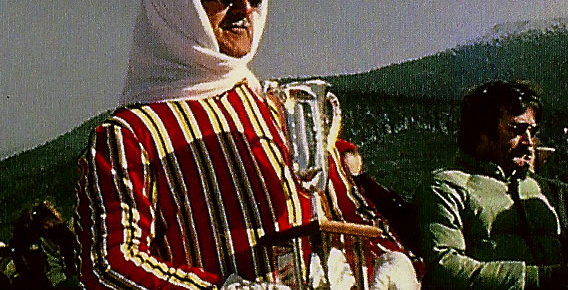
In 1977, a fake sheik fooled the crowds — and the press — at Winter Park.
In the winter of 1977, a pro-am charity race atWinter Park,Colorado, made international headlines for its unexpected celebrity competitor. It wasn’t Ingemar Stenmark, who dominated the World Cup season. It was Sheik Abdul Haddad, who swept through the slalom gates atWinter Park, robes and burnoose flapping, and captured his fifteen minutes of fame.
Sheik Abdul showed up unannounced to compete in the Pro-Am charity race held during the First of Denver Pro Race weekend. The fundraiser supported Hal O’Leary’s innovative Winter Park Handicapped Program. The sheik was placed on the team captained by pro racer Jake Hoeschler (who was also director of skiing atWinter Park), with Heisman Trophy-winning football player Doak Walker and Andy Love, son of former Colorado Governor John Arthur Love. As the sheik flapped and fluttered across the finish line, the press corps clustered around him. The sheik was a sensation: in the aftermath of the OPEC crisis, the very idea of an oil sheik carried the aura of vast wealth and veiled threat. The press wanted pictures, and quotes. All the VIPs wanted to meet him. The sheik’s bodyguard and translator intervened, explaining that Haddad spoke no English.
It turned out he spoke no Arabic, either. When photos and stories about the skiing sheik went out over the AP and UPI wires people inDuluth,Minn., chuckled. Color photos of Sheik Abdul made the papers inParis, Moscow and Tokyo. But the Duluth papers quickly identified him as George S. Haddad, 56, owner of the Haddad Family Shoe Store and of Lebanese descent. The shoe store was located a few doors up from the Continental Ski Shop, where George was a frequent customer. He was also a well-known figure at Lutsen and other local ski areas, where he often skied in his “Arab” robes, no doubt avoiding entanglement in rope tows. The robes had been sewn by his wife, Dorothy Marie Haddad. Haddad even owned a U.S. patent on a bit of ski equipment he had designed: a retractable crampon to help a skier climb.
When the Duluth papers had their say, the story unwound. Hoeschler had arranged for Gerald Ford, Ethel Kennedy and Clint Eastwood to ski in the Pro-Am, but when Winter Park shifted the dates, Ford and Kennedy cancelled in favor of previous obligations.
A few days of panic ensued, and then Hoeschler, passing through Continental Ski Shop, spotted a poster of Haddad skiing inAspen, robes and all. If he couldn’t get an ex-president onto Eastwood’s team, Hoeschler figured he could get a sheik.
And so, with the complicity of Winter Park President Gerry Groswold, Sheik Haddad arrived at Winter Park in a limousine. He came with a bodyguard in the person of Jim Bach of the Continental Ski Shop, and with translator George Abdullah, who taught at Drake University in Iowa. Haddad later claimed he was scared to run the course: With oil prices so high, he was afraid “some fanatic” might take a shot at him.
When the Duluth papers broke the story of the hoax, officials at AP and UPI were furious. UPI, in particular, had been burned in 1976 when Vail sent them a photo of a blizzard that had been taken two years earlier. They felt that the reputation of the press was at stake. But no one from any of the papers or wire services had bothered to fact-check any of the “oil sheik” stories.
The fallout for Hal O’Leary’s program was spectacular. People around the world saw the story and felt inspired to send checks to the handicapped ski team. “We raised 20 times as much over the course of the year as we had ever done before,” O’Leary told Hoeschler.
Haddad went back to his shoe store, and to Lutsen, where he was now a local hero. Hoeschler ran out his contract with Winter Park and returned to his law practice in Minneapolis.
A year passed. Ingemar Stenmark won the World Cup Championship for his third and last time. Groswold invited Haddad, and Hoeschler, back to Winter Park for the Pro-Am. And Dorothy Marie sewed up a new set of robes, edged in gold.
Today, of course, skiing sheiks are a dime a dozen. They all own homes in Aspen. But there’s not a burnoose to be seen: they wear Bogner.
This story appears in the May-June 2013 issue of Skiing History magazine. To read more of Skiing History, subscribe today.


